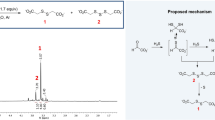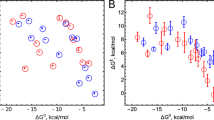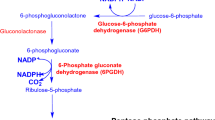Abstract
WHEN glutathione is oxidized by copper ions or the cytochrome c–cytochrome-oxidase system in the presence of pyruvate, the added pyruvate is partially oxidized to acetic acid and carbon dioxide1. It was suggested that this reaction occurred by the production of a hemimercaptol compound between pyruvate and glutathione which is oxidized instead of free glutathione. Slater2, disproving the hemimercaptol hypothesis, emphasized a model similar to that found by one of us3 for the coupled oxidation of pyruvate by ascorbic acid, which involves the intermediate production of hydrogen peroxide. But the two points made by Slater in support of his postulate have been found to be inconsistent : (1) the chromatic effect of the methylglyoxal–glutathione complex in the ultra-violet, not shown by the pyruvate–glutathione complex, is mainly due to the enediol compound in equilibrium with the thio-ester resulting from the interaction4; enediols and thioesters are not likely to be produced by the interaction of glutathione with pyruvate, which forms only mercaptols; (2) the effect of catalase has been thoroughly investigated and we have been unable to reproduce the inhibitory effect reported by Slater. Moreover, (3) we now present evidence that in our experimental conditions a complex between glutathione and pyruvate is actually formed.
This is a preview of subscription content, access via your institution
Access options
Subscribe to this journal
Receive 51 print issues and online access
$199.00 per year
only $3.90 per issue
Buy this article
- Purchase on Springer Link
- Instant access to full article PDF
Prices may be subject to local taxes which are calculated during checkout
Similar content being viewed by others
References
Cavallini, D., Biochem. J., 49, 1 (1951).
Slater, E. C., Nature, 170, 970 (1952).
Cavallini, D., Arch. Fisiol., 45, 189 (1946).
Racker, E., Biochim. Biophys. Acta, 9, 577 (1952).
Schubert, M. P., J. Biol. Chem., 114, 341 (1936).
Keilin, D., and Hartree, E. F., Biochem. J., 39, 293 (1945).
Strittmatter, P., and Ball, E. G., J. Biol. Chem., 213, 445 (1955).
Author information
Authors and Affiliations
Rights and permissions
About this article
Cite this article
CAVALLINI, D., AZZONE, G. & STIRPE, F. Coupled Oxidation of Keto-Acids with Glutathione. Nature 177, 1232–1233 (1956). https://doi.org/10.1038/1771232a0
Issue Date:
DOI: https://doi.org/10.1038/1771232a0
Comments
By submitting a comment you agree to abide by our Terms and Community Guidelines. If you find something abusive or that does not comply with our terms or guidelines please flag it as inappropriate.



